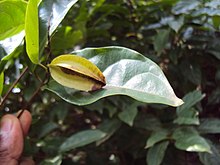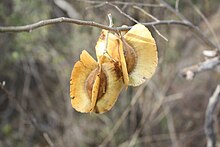Long threads
| Long threads | ||||||||||||
|---|---|---|---|---|---|---|---|---|---|---|---|---|
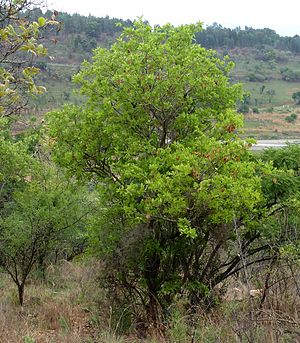
|
||||||||||||
| Systematics | ||||||||||||
|
||||||||||||
| Scientific name | ||||||||||||
| Combretum | ||||||||||||
| Loefl. |
The long filaments ( Combretum ) are a genus of plants in the winged family (Combretaceae). The other German trivial name "wing nuts" should be avoided, as it is already assigned to the plant genus Pterocarya .
description




Appearance and leaves
The evergreen or deciduous Combretum species are always woody plants that rarely grow as independently upright trees or bushes to semi-shrubs , but mostly as lianas . The thin hairs ( trichomes ) are unicellular.
The opposite, whorled, rarely alternate arranged on the branches of leaves usually have petioles that sometimes, especially in climbing species as more or less hooked thorns remain. The mostly simple leaf blades are very variable in shape depending on the species, most often they are elliptical, elongated-elliptical or broad-ovoid. The leaf surfaces are bald or hairy and often conspicuously scaled. The leaf blades often have domatia .
Inflorescences and flowers
The final, pendant, or between the nodes ( Nodien standing) ährigen , traubigen or rispigen inflorescences are simple or compound.
The hermaphroditic flowers are radial symmetry or, more rarely, slightly zygomorphic and four or five-fold with a double flower envelope . The flower cups (Hypanthium) is in the lower flower cups, of the ovary , divided and surrounds upper multitubular flower cups, which is often brightly colored. The mostly four or five, seldom more, sepals are inserted on the upper end of the flower cup and overgrown to a length of no more than 2 centimeters in a funnel to bowl shape and somewhat contracted above the ovary, usually with four or five, rarely more triangular to primate or thread-like to scale-like calyx teeth. The usually four to five petals can be conspicuous and protrude beyond the calyx teeth or be small and inconspicuous or even absent. The colors of the petals range from white to yellow and orange to red or purple. There are usually one or two circles, each with four or five stamens , which usually protrude above the calyx tube. There may be a bald or hairy discus. The unicameral ovary is subordinate. The stylus sometimes ends in a more or less extended scar .
Fruits and seeds
The maximum short-stemmed, seeded false fruit (Pseudokarp) is usually dry, rarely fleshy and longitudinally four- to fünfflügelig to -kantig. So samaroid wing nuts are formed. The pericarp is usually thin and papery, sometimes leathery, rarely fleshy. The fruits usually remain closed even when ripe.
ecology
The few species whose flowers have clearly developed, showy petals are pollinated by swarmers ( Sphingidae ).
The caterpillars of Coeliades forestan and Pseudaphelia apollinaris feed on some Combretum species .
Depending on the species, the diaspores spread in very different ways.
distribution
The approximately 250 Combretum species are widespread in the tropics and subtropics . It occurs mainly in tropical and southern Africa , also in the Neotropic , in tropical Asia and in Madagascar . A center of biodiversity lies in the afrotropic area. There are no natural occurrences of Combretum in Australia and the Pacific Islands. It represents some of the most important woody species of the Sudano-Zambian savannas .
Systematics
The genus Combretum was established in 1758 by Pehr Löfling in Iter Hispanicum , p. 308. Type species is Combretum fruticosum (Loefl.) Stuntz . Synonyms for Combretum Loefl. are: Aetia Adans. , Bureava Baill. , Cacoucia Aubl. , Calopyxis Tul. , Campylochiton Welw. ex Hiern , Campylogyne Welw. ex Hemsl. , Chrysostachys Pohl , Cristaria Sonn. , Embryogonia flower , Forsgardia Vell. , Gonocarpus Ham. , Grislea L. , Hambergera Scop. , Kleinia Crantz , Physopodium Desv. , Poivrea Comm. ex Thouars , Schousboea Willd. , Seguiera Rchb. ex Oliv. , Sheadendron G. Bertol . , Sphalanthus Jack , Udani Adans. The approximately 17 species of the genus Quisqualis L. have also belonged to the genus Combretum since 2010 .
The genus Combretum belongs to the subtribe Combretinae from the tribe Combreteae in the subfamily Combretoideae within the family Combretaceae . Combretum is the type genus of the Combretaceae family .
The genus Combretum is divided into three sub-genera:
- Subgenus Apetalanthum Exell & Stace :
- It contains only one species: Combretum apetalum Wall. ex short .
- Subgenus Cacoucia (Aubl.) Exell & Stace : It contains 13 sections with a total of about 78 species:
- Section Poivrea (Comm. Ex Thouars) Eichler : It contains about 31 species.
- Section Conniventia Engl. & Diels : It contains about 20 species.
- Subgenus Combretum : It contains about nine sections with about 170 species:
- Section Angustimarginata Engl. & Diels : It contains about six South African species.
- Section Ciliatipetala Engl. & Diels : It contains about ten species in Africa and on the Arabian Peninsula.
- Section Macrostigmatea Engl. & Diels : It contains about four species.
- Section Spathulipetala Engl. & Diels : It contains only one species.
- Section Hypocrateropsis Engl. & Diels : It contains about six species.
- Section Glabripetala Engl. & Diels
- Metallicum Exell section
- Section Campestria Engl. & Diels
- Section Breviramea Engl. & Diels
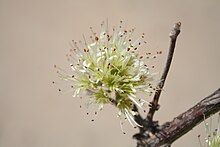












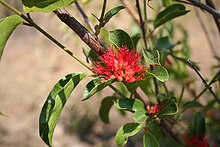

The genus Combretum contains about 250 species. Here is a selection of species:
- Combretum aculeatum Vent.
- Combretum acuminatum Roxb.
- Combretum acutifolium Exell
- Combretum acutum M.A. Lawson
- Combretum adenogonium Steud. ex A.Rich. : It is widespread in tropical Africa: Botswana , Zimbabwe and Mozambique .
- Combretum adrianii Jongkind : It occurs, for example, in northern Mozambique.
- Combretum afzelii G.Don
- Combretum alatum Craib
- Combretum albiflorum (Tul.) Jongkind
- Combretum albopunctatum Suess.
- Combretum album Pers.
- Combretum alfredii Hance : It thrives at altitudes of 0 to 800 meters in the Chinese provinces of Guangdong, Guangxi, southern Hunan (only in Yizhang) and in southern Jiangxi (only in Longnan).
- Combretum andongense Engl. & Diels
- Combretum andradae Exell & JGGarcía
- Combretum angolense Welw. ex MALawson
- Combretum angustipetalum Chiov.
- Combretum annulatum Craib
- Combretum apetalum Wall. ex In short : it occurs in Southeast Asia.
- Combretum aphanopetalum Engl. & Diels
- Combretum apiculatum Sond. : It occurs in Africa.
- Combretum argenteum Bertol.
- Combretum argyrotrichum Welw. ex MALawson
- Combretum assimile Eichler
- Combretum atropurpureum Engl. & Diels
- Combretum aureonitens Engl. & Gilg
- Combretum auriculatum Engl. & Diels
- Combretum barbatum G. Don
- Combretum batesii Exell
- Combretum bauchiense Hutch. & Dalziel
- Combretum bipindense Engl. & Diels
- Combretum blepharopetala Wickens
- Combretum boinensis Jongkind
- Combretum bracteatum (C.Lawson) Engl. & Diels
- Combretum bracteosum (Hochst.) Engl. & Diels : It occurs in the South African provinces of Eastern Cape and KwaZulu-Natal .
- Combretum brassiciforme Exell
- Combretum brevistylum Eichler
- Combretum bricchettii Engl. & Diels
- Combretum brunneum Engl. & Diels
- Combretum butyrosum (G.Bertol.) Tul.
- Combretum cacoucia Exell ex Sandwith : It occurs in South America.
- Combretum caffrum (Eckl. & Zeyh.) Kuntze : It occurs only in the South African province of Eastern Cape.
- Combretum camporum Engl .: It occurs in Angola and Zaire.
- Combretum capitatum De Wild. & Exell
- Combretum capituliflorum Fenzl ex Schweinf.
- Combretum capuronii Jongkind
- Combretum carringtonianum Exell & JGGarcía
- Combretum caudatisepalum Exell & JGGarcía
- Combretum celastroides Welw. ex MALawson
- Combretum chinense G. Don
- Combretum chionanthoides Engl. & Diels
- Combretum cinereopetalum Engl. & Diels
- Combretum cinnabarinum Engl. & Diels
- Combretum clarense Jongkind
- Combretum coccineum (Sun.) Lam. : It occurs only in Madagascar and | Mauritius.
- Combretum collinum Fresen. : It is widespread from tropical to southern Africa.
- Combretum comosum G.Don : It occurs in tropical West Africa.
- Combretum conchipetalum Engl. & Diels
- Combretum confertum (Benth.) MALawson
- Combretum × confusum Merr. & Rolfe
- Combretum congolanum Liben
- Combretum constrictum (Benth.) MALawson : It occurs in Africa.
- Combretum contractum Engl. & Diels
- Combretum copaliferum Chiov.
- Combretum cordofanum Engl. & Diels
- Combretum coriifolium Engl. & Diels
- Combretum coursianum (H.Perrier) Jongkind
- Combretum cufodontii Chiov.
- Combretum cuspidatum Planch. ex Benth.
- Combretum cyclocarpum Chiov.
- Combretum decandrum Jacq.
- Combretum decaryi Jongkind
- Combretum deciduum Collett & Hemsl.
- Combretum demeusei De Wild.
- Combretum discolor deaf.
- Combretum dolichopetalum Engl. & Diels
- Combretum dolichopodum Gilg
- Combretum duarteanum Cambess.
- Combretum echirense Jongkind
- Combretum edwardsii Exell
- Combretum elaeagnoides Klotzsch
- Combretum eriogynum (H.Perrier) Jongkind
- Combretum Erlangerianum Engl. Ex Diels
- Combretum erosum Jongkind
- Combretum erythrophloeum Gilg & Ledermann ex Engl.
- Combretum erythrophyllum (Burch.) Sond. : It is widespread in Botswana, Mozambique, Namibia, Zimbabwe, Swaziland and South Africa.
- Combretum esteriense Jongkind
- Combretum evisceratum (H.Perrier) Jongkind
- Combretum exalatum Engl.
- Combretum exannulatum (O.Hoffm.) Engl. & Diels
- Combretum excelsum Keay
- Combretum exellii Jongkind
- Combretum falcatum (Welw. Ex Hiern) Jongkind : It occurs in Africa.
- Combretum farinosum Kunth : It occurs from Mexico to Central America.
- Combretum flammeum Welw. ex here
- Combretum foliatum Craib
- Combretum frangulifolium Kunth
- Combretum fruticosum (Loefl.) Stuntz : It is widespread from Mexico to Central and South America.
- Combretum fulvum Keay
- Combretum fuscum Planch. ex Benth.
- Combretum gabonense Exell
- Combretum gallabatense Schweinf.
- Combretum germainii Liben
- Combretum ghesquierei Liben
- Combretum gillettianum Liben
- Combretum glabrum DC.
- Combretum glutinosum Perr. ex DC.
- Combretum goetzei Engl. & Diels
- Combretum goldieanum F. Muell.
- Combretum goossensii De Wild. & Exell
- Combretum gossweileri Exell
- Combretum gracile Schott
- Combretum graciliflorum Stace
- Combretum grandidieri Drake
- Combretum grandiflorum G.Don : It occurs in tropical West Africa.
- Combretum harmsianum Diels
- Combretum harrisii Wickens
- Combretum hartmannianum Schweinf.
- Combretum haullevilleanum De Wild.
- Combretum hensii Engl. & Diels
- Mouse-eared long thread ( Combretum hereroense Schinz ): It occurs in Africa.
- Combretum hilariana D Dietr.
- Combretum hispidum MALawson
- Combretum holstii Engl.
- Combretum homalioides Hutch. & Dalziel
- Combretum illairii Engl.
- Ancestral tree ( Combretum imberbe Wawra ): It is widespread in from Tanzania to Angola , Mozambique, Botswana , Namibia , Limpopo and Mpumalanga .
- Combretum incertum Hand.-Mazz.
- Rangoon creeper ( Combretum indicum (L.) DeFilipps , Syn .: Quisqualis indica L. ): It occurs in Africa and Asia.
- Combretum inflatum Jongkind
- Combretum ivanii Jongkind
- Combretum kasaiense Liben
- Combretum kirkii MALawson : In the Zambezi Valley, it occurs in Malawi , Mozambique, Zambia and Zimbabwe.
- Combretum klossii Ridl.
- Combretum klotzschii Welw. ex MALawson
- Combretum kostermansii Exell
- Combretum kraussii Hochst. : It occurs in southern Africa in Mozambique, Swaziland, Limpopo, Mpumalanga Eastern Cape and KwaZulu-Natal.
- Combretum kwangsiense HLLi
- Combretum lanceolatum Pohl ex Eichler
- Combretum lanuginosum G.Don
- Combretum lasiocarpum Engl. & Diels
- Combretum latialatum Engl.
- Combretum latifolium flower : It occurs in Asia.
- Combretum laxum Jacq.
- Combretum lecardii Engl. & Diels
- Combretum leprosum Mart. : It occurs in South America.
- Combretum lindense Exell & Mildbr.
- Combretum linear Keay
- Combretum linyenense Hand.-Mazz.
- Combretum lisowskii Jongkind
- Combretum llewelynii JFMacbr.
- Combretum lokele Liben Accepted
- Combretum longicollum Jongkind
- Combretum longipilosum Engl. & Diels
- Combretum longispicatum (Engl.) Engl. & Diels
- Combretum louisii Liben
- Combretum lukafuensis De Wild.
- Combretum luxenii Exell
- Combretum macrocalyx (Tul.) Jongkind
- Combretum mannii G.Lawson ex Engl. & Diels
- Combretum marchettii Chiov.
- Combretum mardaf Chiov.
- Combretum marginatum Engl. & Diels
- Combretum marquesii Engl. & Diels
- Combretum mellifluum Eichler
- Combretum meridionalis (H.Perrier) Jongkind
- Kinkéliba ( Combretum micranthum G.Don ): It occurs in tropical West Africa.
- Combretum microphyllum Klotzsch : It is widespread in tropical Africa and extends to Mpumalanga and KwaZulu-Natal.
- Combretum minimipetalum Chiov.
- Combretum mkuzense J.D. Carr & Retief
- Combretum moggii Exell
- Combretum molle R.Br. ex G.Don : It is widespread from the Arabian Peninsula through the African continent to northern and eastern South Africa.
- Combretum monetaria Mart.
- Combretum mooreanum Exell
- Combretum mortehanii De Wild. & Exell
- Combretum mossambicense (Klotzsch) Engl .: It is widespread from Angola, Botswana, Mozambique, Zambia, Zimbabwe to Limpopo, Mpumalanga and the North Cape .
- Combretum mucronatum Schumach. & Thonn. : It occurs in Africa.
- Combretum multinervium Exell
- Combretum mweroense Baker
- Combretum nanum Buch.-Ham. ex D.Don
- Combretum ndjoleense Jongkind
- Combretum nigrescens King
- Combretum nigricans Lepr. ex Guill. & Perr.
- Combretum nioroense Aubrév. ex Keay
- Combretum niphophilum Gilg & Ledermann ex Engl.
- Combretum obangense (Baker f.) Hutch. & Dalziel
- Combretum obovatum F. Hoffm. : Its range includes Tanzania, Mozambique, Zambia and Zimbabwe.
- Combretum obscurum Tul.
- Combretum octagonum (H.Perrier) Jongkind
- Combretum olivaceum Engl.
- Combretum oliviforme A.C. Chao
- Combretum oubanguense Exell
- Combretum oudenhovenii Jongkind
- Combretum ovalifollum Roxb. ex G.Don : It occurs in India and Sri Lanka.
- Combretum oxygonium (Tul.) Jongkind
- Combretum oxystachyum Welw. ex MALawson
- Combretum oyemense Exell
- Combretum padoides Engl. & Diels : It is widespread from tropical Africa to Zimbabwe, Mozambique, Mpumalanga and KwaZulu-Natal.
- Combretum paniculatum Vent. : It occurs in Africa.
- Combretum paradoxum Welw. ex MALawson
- Combretum paraguariense (Eichler) Stace
- Combretum parvulum Engl. & Diels
- Combretum paucinervium Engl. & Diels
- Combretum pavonii G.Don
- Combretum pecoense Exell
- Combretum pentagonum M.A. Lawson
- Combretum perakense M.G. Gangop. & Chakrab.
- Combretum petrophilum Retief
- Combretum phaeocarpum Mart.
- Combretum pilosum Roxb. ex G.Don : It occurs in Bangladesh, Cambodia, India, Laos, Myanmar, Thailand, Vietnam and in China.
- Combretum pisoniiflorum (Klotzsch) Engl .: It occurs in Malawi, Tanzania and Mozambique.
- Combretum pisonioides deaf.
- Combretum platypetalum Welw. ex MALawson
- Combretum platypterum (Welw.) Hutch. & Dalziel
- Combretum polyanthum Jongkind
- Combretum polystictum here
- Combretum procursum Craib
- Combretum psidioides Welw.
- Combretum punctatum flower : It occurs in Bangladesh, Bhutan, India, Indonesia, Malaysia, Myanmar, Nepal, the Philippines, Thailand, Vietnam and China.
- Combretum purpurascens Hand .-- Mazz.
- Combretum purpureiflorum Engl.
- Combretum pyramidatum Desv.
- Combretum pyrifolium short
- Combretum quadrangular short
- Combretum quadratum Craib
- Combretum rabiense Jongkind
- Combretum racemosum P.Beauv.
- Combretum razianum K.G.Bhat
- Combretum relictum Hutch. & Dalziel
- Combretum rhodanthum Engl. & Diels
- Combretum richardianum Van Heurck & Müll.Arg.
- Combretum riggenbachianum Gilg & Ledermann ex Engl.
- Combretum robinsonii Fawc. & Rendle
- Combretum robustum Jongkind
- Combretum robynsii Exell
- Combretum rohrii Exell
- Combretum rotundifolium Rich. : It occurs in South America.
- Combretum rovirosae Exell
- Combretum roxburghii Spreng. : It occurs in India, Nepal, Bangladesh, Laos, Myanmar, Thailand, Vietnam and China.
- Combretum rueppellianum A.Rich.
- Combretum rupicola Ridl.
- Combretum sanjappae Chakrab. & Lakra
- Combretum scandens Liben
- Combretum schumannii Engl.
- Combretum schweinfurthii Engl. & Diels
- Combretum sericeum G.Don
- Combretum somalense Engl. & Diels
- Combretum sordidum Exell
- Combretum sphaeroides (Tul.) Jongkind
- Combretum spinosum Bonpl.
- Combretum stefaninianum Pamp.
- Combretum stenopterum Exell
- Combretum stocksii Sprague
- Combretum struempellianum Gilg & Ledermann ex Engl.
- Combretum stylesii O. Maurin, Jordaan & AEvan Wyk : This species was first described in 2010 and occurs in the Eastern Valley Bushveld, KwaZulu-Natal , South Africa, type location is the Tugela River Valley.
- Combretum subglabratum De Wild.
- Combretum sublancifolium Chiov.
- Combretum subumbellatum (Baker) Jongkind
- Combretum sundaicum Miq. : It occurs in Indonesia, Malaysia, Singapore, Thailand, Vietnam and China.
- Combretum tanaense Clark
- Combretum tarquense Clark
- Combretum tenuipetiolatum Wickens
- Combretum tessmannii Gilg ex Engl.
- Combretum tetragonocarpum short
- Combretum tetralophoides Slooten
- Combretum tetralophum C.B. Clarke
- Combretum teuschii O. Hoffm.
- Combretum tibatiense Gilg & Ledermann ex Engl.
- Combretum tomentosum G.Don
- Combretum towaense Engl. & Diels
- Combretum trichophyllum Baker
- Combretum trifoliatum Vent.
- Combretum ulei Exell
- Combretum umbricolum Engl.
- Combretum vendae A.E. van Wyk
- Combretum vernicosum Rusby
- Combretum villosum (Tul.) Jongkind
- Combretum violaceum (Tul.) Jongkind
- Combretum viscosum Exell
- Combretum wallichii DC. : It occurs in Bangladesh, Bhutan, India, Myanmar, Nepal, Vietnam and in China.
- Combretum wandurraganum R.E. Schul .
- Combretum wattii Exell
- Combretum wilksii Jongkind
- Combretum winitii Craib
- Combretum xanthothyrsum Engl. & Diels
- Combretum youngii Exell
- Combretum yuankiangense C.C. Huang & SCHuang
- Combretum zenkeri Engl. & Diels
- Combretum zeyheri Sond. : It is widespread from tropical Africa to Botswana, Namibia, Zimbabwe, Mozambique, Swaziland and KwaZulu-Natal.
The following species is assigned to a different genus and family:
- Combretum macrocarpum P.Beauv. : Is now Petersianthus macrocarpus (P.Beauv.) Liben and is classified in the family Lecythidaceae.
use
Numerous species, such as Kinkéliba ( Combretum micranthum ), are used in traditional medicine in Africa and India.
swell
- Jie Chen, Nicholas J. Turland: Combretaceae. , P. 316 text online with the same text as the printed work , In: Wu Zheng-yi, Peter H. Raven, Deyuan Hong (Ed.): Flora of China. Volume 13: Clusiaceae through Araliaceae. Science Press and Missouri Botanical Garden Press, Beijing and St. Louis, 2007, ISBN 978-1-930723-59-7 . (Sections Description and Distribution)
- AW Exell: Flora Zambesiaca , Volume 4, 1978: Combretaceae : Combretum Loefl. (Section description)
- Olivier Maurin: Dissertation, University of Johannesburg, December 2009: A phylogenetic study of the family Combretaceae with emphasis on the genus Combretum in Africa : PDF . (Sections Description, Systematics and Distribution)
Individual evidence
- ^ Robert Zander : Zander. Concise dictionary of plant names. Edited by Walter Erhardt , Erich Götz, Nils Bödeker, Siegmund Seybold . 17th edition. Eugen Ulmer, Stuttgart 2002, ISBN 3-8001-3573-6 .
- ^ Entry in the Flora of Mozambique .
- ↑ Combretum at Tropicos.org. Missouri Botanical Garden, St. Louis
- ↑ a b c d e f Combretum in the Germplasm Resources Information Network (GRIN), USDA , ARS , National Genetic Resources Program. National Germplasm Resources Laboratory, Beltsville, Maryland.
- ↑ Oliver Maurin, Mark W. Chase, M. Jordaan, Michelle van der Bank: Phylogenetic relationships of Combretaceae inferred from nuclear and plastid DNA sequence data: implications for generic classification , In: Botanical Journal of the Linnean Society , Volume 162, Issue 3 , 2010, pp. 453-476. doi : 10.1111 / j.1095-8339.2010.01027.x PDF.
- ↑ a b Oliver Maurin, AE VanWyk, M. Jordaan, Michelle van der Bank: A new species of Combretum section Ciliatipetala (Combretaceae) from southern Africa, with a key to the regional members of the section , In: South African Journal of Botany , Volume 77, Issue 1, 2011 pp. 105–111: PDF .
- ↑ a b c d e f Jie Chen, Nicholas J. Turland: Combretaceae. , P. 316 text online with the same text as the printed work , In: Wu Zheng-yi, Peter H. Raven, Deyuan Hong (Ed.): Flora of China. Volume 13: Clusiaceae through Araliaceae. Science Press and Missouri Botanical Garden Press, Beijing and St. Louis, 2007, ISBN 978-1-930723-59-7 .
Web links
- Combretum . In: U. Brunken, M. Schmidt, S. Dressler, T. Janssen, A. Thiombiano, G. Zizka: West African plants - A Photo Guide. Senckenberg Research Institute, Frankfurt am Main 2008.
- Brief description from Flora of Zimbabwe . (engl.)
- Key to sections of subgen. Combretum (flowering material) .
- Gamal EB El Ghazali: A study on the pollen morphology of the genus Combretum Loefl. and its taxonomic significance. In: South Asian Journal of Experimental Biology , Volume 6, Issue 4, pp. 131-142. PDF.







